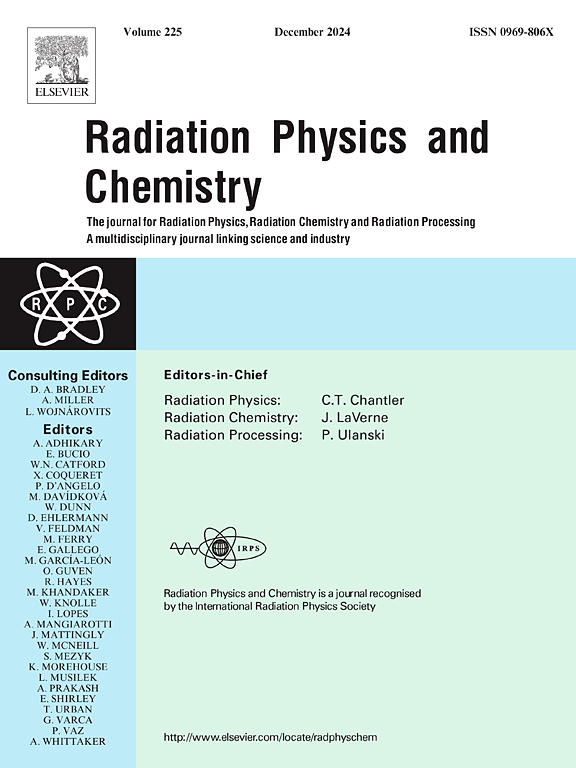对伽玛刀放射外科技术治疗对不同脑部病变患者身体部位的影响进行放射生物学评估:辐射照射是否也会影响患者的血液成分?
IF 2.8
3区 物理与天体物理
Q3 CHEMISTRY, PHYSICAL
引用次数: 0
摘要
这项研究的目的是研究剂量分级伽玛刀放射外科手术(GKRS)对患者器官的安全性,评估输送到身体各部位的等效和有效剂量,并检查对血液参数的影响。病例研究包括 30 名接受 GKRS 治疗的不同脑部病变患者。为了评估不同身体部位受到的辐射量,研究人员使用辐射剂量计测量了伽马剂量率。结果表明,考虑到辐照剂量和辐照时间,GKRS 射束能有效地对患者身体产生后向散射。与其他部位相比,离目标(辐射束)较近的身体部位受到的伽马剂量较高。对三叉神经痛和脑膜瘤这两种脑部病变分别采用了高辐照剂量(80 Gy,46.47 分钟)和低辐照剂量(10 Gy,15.7 分钟)两种配置,测得了伽马剂量率的高值和低值。根据国际准则对放射生物学效应进行了估计,结果显示辐射对某些器官产生了重大影响。对血液学影响也进行了评估,其变化取决于辐照剂量和辐照时间。一些血细胞受到了与辐射有关的影响。值得注意的是,与听神经瘤脑损伤的低剂量(10 Gy,照射时间 15.7 分钟)相比,三叉神经脑损伤的高剂量(80 Gy,照射时间 46.47 分钟)对血液参数的影响更大。因此,伽马射线剂量的增加会对特定的血液参数产生重大影响。本文章由计算机程序翻译,如有差异,请以英文原文为准。
Radiobiological evaluation of the impact of the treatment with the gamma knife radiosurgery technique on the body parts of patients with different brain lesions: Does the radiation exposure affect also the Patient's blood components?
The research aimed to study the safety of the dose-staged Gamma Knife radiosurgery (GKRS) on the patients' organs, by evaluating the equivalent and effective doses delivered to various body parts and examining the impacts on the blood parameters. The case study consisted of 30 patients with different brain lesions undergone to GKRS. To assess the radiation exposure on the different body parts, gamma dose rates were measured using a survey radiation dosimeter. The results demonstrated that the GKRS beam effectively backscatters on the patient's body, considering the irradiation doses and the exposure time. Body parts in closer proximity to the target (radiation beam) received higher gamma doses compared to other areas. High and low values of gamma dose rate were measured in the two configurations: high irradiation dose (80 Gy for 46.47 min) and low irradiation dose (10 Gy per 15.7 min) for the brain lesions of Trigeminal Neuralgia and Meningioma, respectively. Radiobiological effects were estimated following the international guidelines revealing significant radiation impacts on some organs. Hematological effects were also evaluated with variations depending on the radiation exposure dose and the exposure time. Some blood cells showed radiation-related impacts. Notably, the high dose of 80 Gy administered over 46.47 min of exposure for trigeminal brain lesions had a greater influence on the blood parameters compared to the low dose of 10 Gy over 15.7 min of exposure for acoustic neuroma brain lesions. Consequently, it turned out that increases in gamma-ray doses resulted in significant impacts on specific blood parameters.
求助全文
通过发布文献求助,成功后即可免费获取论文全文。
去求助
来源期刊

Radiation Physics and Chemistry
化学-核科学技术
CiteScore
5.60
自引率
17.20%
发文量
574
审稿时长
12 weeks
期刊介绍:
Radiation Physics and Chemistry is a multidisciplinary journal that provides a medium for publication of substantial and original papers, reviews, and short communications which focus on research and developments involving ionizing radiation in radiation physics, radiation chemistry and radiation processing.
The journal aims to publish papers with significance to an international audience, containing substantial novelty and scientific impact. The Editors reserve the rights to reject, with or without external review, papers that do not meet these criteria. This could include papers that are very similar to previous publications, only with changed target substrates, employed materials, analyzed sites and experimental methods, report results without presenting new insights and/or hypothesis testing, or do not focus on the radiation effects.
 求助内容:
求助内容: 应助结果提醒方式:
应助结果提醒方式:


